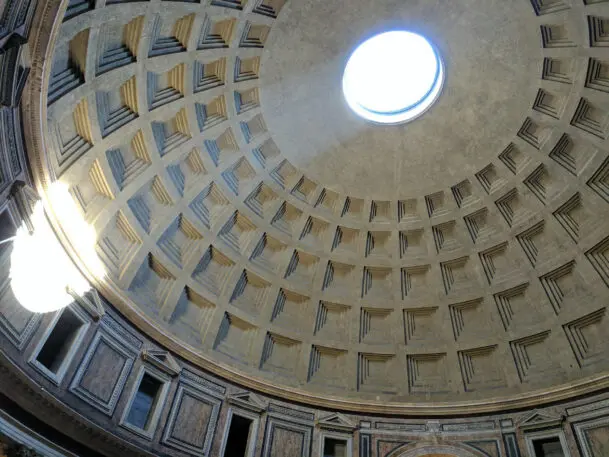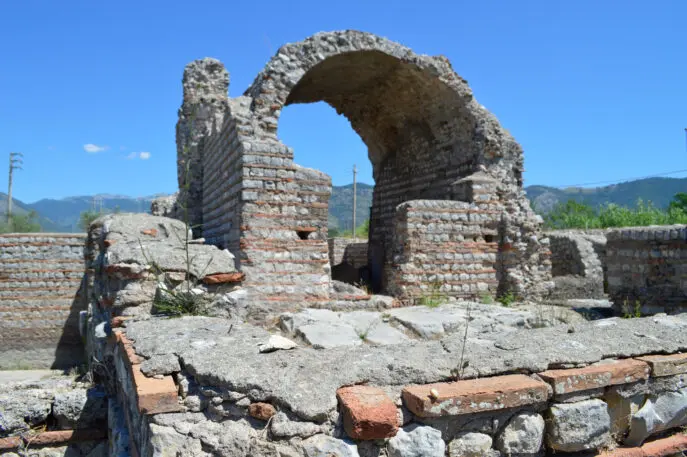It starts with a riddle that has long puzzled scientists: The Pantheon was built almost 2,000 years ago. The iconic structure, which boasts the world’s largest unreinforced concrete dome, has endured Barbarian invasions, earthquakes, fires, and storms. Despite all of this, it still stands intact today. Meanwhile countless more recent concrete buildings have cracked, corroded, and succumbed just a few decades after they were built. How is that possible?

A team of researchers from MIT, Harvard University, as well as laboratories in Italy and Switzerland, might have found an answer in the ingredients and methods the ancient Romans used to mix their concrete. After analyzing a piece of a concrete wall from the ancient city of Privernum near Rome, the researchers found that the concrete has self-healing properties thanks to one unassuming ingredient—lime—and the technique used to mix it in. In other words, buildings like the Pantheon have survived the test of time because they were made of a material that had the ability to repair itself without human intervention.
The findings, which were recently published in the journal Science Advances, offer a fascinating glimpse into Roman engineering, but they can also teach us something about the way we use concrete today.
Concrete isn’t as strong as many people believe it to be. It can crack when the weather is too hot, and when the weather is too cold. It can crack when there’s an earthquake, and it can crack because it’s porous. When it does crack, it will inevitably absorb water that will seep through, freeze, expand, or simply corrode the rebar inside it, causing even more cracks. By some estimates, the maintenance costs required to fix corrosion alone exceed $125 billion every year.

After three years of research, the team believes this Roman-inspired concrete can reduce maintenance costs and extend the life of a building. In fact, the research has led to the creation of a new deep tech startup called Dmat, which first launched in Italy, two years ago, then in the US at the end of 2022. Dmat’s core product is called D-lime—a self-healing concrete that could last 50% longer than traditional concrete by self-repairing small cracks and preventing further deterioration. As its name suggests, the star ingredient of D-lime is calcium oxide, or lime—but more on that in a bit.
The team behind Dmat isn’t manufacturing concrete like the Romans did 2,000 years ago. Instead, they are leveraging the underlying principles behind those ancient techniques and adapting them to modern times, refining the recipe and tweaking the additives, so that the concrete can maximize its self-healing properties.
Based on the researchers’ findings, self-healing concrete could prevent water infiltration, regardless of if cracks end up forming. Professor Admir Masic, an MIT professor of civil and environmental engineering and an author of the study, explains that when lime clusters are mixed with cement and water at a very high temperature, the water around them evaporates, and the clusters, which would have otherwise dissolved, remain embedded in the material. If cracks form at a later stage, water will inevitably seep through those cracks in the form of rain, seawater, or moisture. Except instead of causing trouble as it does with traditional concrete, the water will cause the calcium clusters to dissolve—and fill the newly formed cracks. In the words of Paolo Sabatini, Dmat’s cofounder and CEO: “The water glues the cracks when they form.”
According to Masic, this kind of self-healing concrete would be particularly well suited for places where concrete and water are already interacting, like dams, seawalls, and coastal construction, but D-lime could eventually be used for a wide range of projects, from bridges and tunnels to housing.
Self-healing concrete already exists, though for now, most options are far from being commercialized. Meanwhile, Sabatini says D-lime has passed all the necessary certifications and tests and it will be ready for use in construction “very soon.” It may not last for two millennia, but in a world where 33 billion tons of concrete are poured every year around the world, it’s a promising step in the right direction.
Recognize your brand’s excellence by applying to this year’s Brands That Matter Awards before the early-rate deadline, May 3.